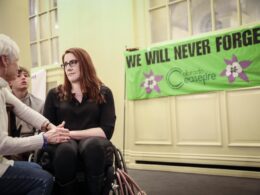The Adams administration faced pushback from outer borough lawmakers during an hours-long grilling by the City Council on Monday over its City of Yes development plan aimed at tackling the ongoing housing crisis by transforming the city’s decades-old zoning rules.
Most council members agreed that the city is facing a crisis. This year, the rental vacancy rate hitting a historic low, an estimated hundreds of thousands of city dwellers are living without homes and over half of New Yorkers are now rent-burdened.
But how to solve that issue, and whether “City of Yes” is the right solution, is hotly contested.
During the six-hour public hearing, hosted by the Council’s Subcommittee on Zoning and Franchises, members questioned Dan Garodnick, director of the Department of City Planning, and Housing Preservation and Development Commissioner Adolfo Carrión Jr. about how “City of Yes for Housing Opportunity” would change the landscape of their neighborhoods and impact their constituents.
The plan, if voted through by the Council, would relax the current strict zoning rules — which dictate what can be built and where — across the city to allow for “a little more housing” to be created in every neighborhood.
“This is the most pro-housing policy in the history of New York City zoning,” Garodnick said. “We’ve never attempted to do something like this. It’s the first time that a mayoral administration is taking action to create new housing in every neighborhood from the lowest density to the highest density.”
Among other changes, the “City of Yes” plan would make it easier to convert old office buildings into apartments and allow new housing to be built about 20% larger than otherwise allowed if the extra space is affordable in taller, denser neighborhoods; quieter, more suburban areas could see more so-called “granny flats” such as converted basements and attics and lift — but not get rid of — parking requirements for new housing.
“This council knows that zoning reform alone cannot fully address the wide-ranging housing needs of New Yorkers,” Speaker Adrienne Adams said during her opening remarks, listing other aspects, like pathways to home ownership, deeper affordability and tenant protections.
Some of the biggest pushback to the plan came from officials representing lower-density neighborhoods with fewer public transit options in the outer boroughs, with many expressing concerns about the parking proposal.
“[Department of City Planning] says that the City of Yes is not a one size fits all, but that’s exactly what the parking proposal is, removing parking requirements across the city regardless of access to transit or other factors,” Bronx Councilmember Rafael Salamanca Jr. said.
Councilmembers also criticized the plan for what they said was a lack of community engagement.
“Our communities were just given a few months to understand these complicated proposals and to propose modifications that address their specific housing needs,” Subcommittee Chair Kevin Riley said. “As a result, many of our communities are understandably upset. I want to emphasize how critical it is that communities be viewed as equal partners and not obstacles.”
Zoning for Housing Opportunity has raised other criticisms during the past several months of review, including that it does not directly build any new housing, that it represents a handout to developers, does not include any tenant protections and is too dense a proposal.
“We’ve heard a lot of concern about what this might mean in low-density areas,” Garodnick said. “Some claim that ‘City of Yes’ will change low-density areas beyond recognition and lead to neighborhood extinction events. In fact, I think you will find that the change would be very modest.”
A second day of hearing focused on public testimony is set for Tuesday, and the council is expected to hold a final vote on the plan later this fall.








